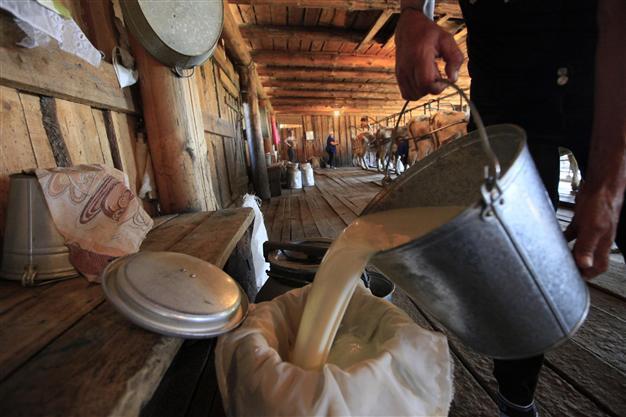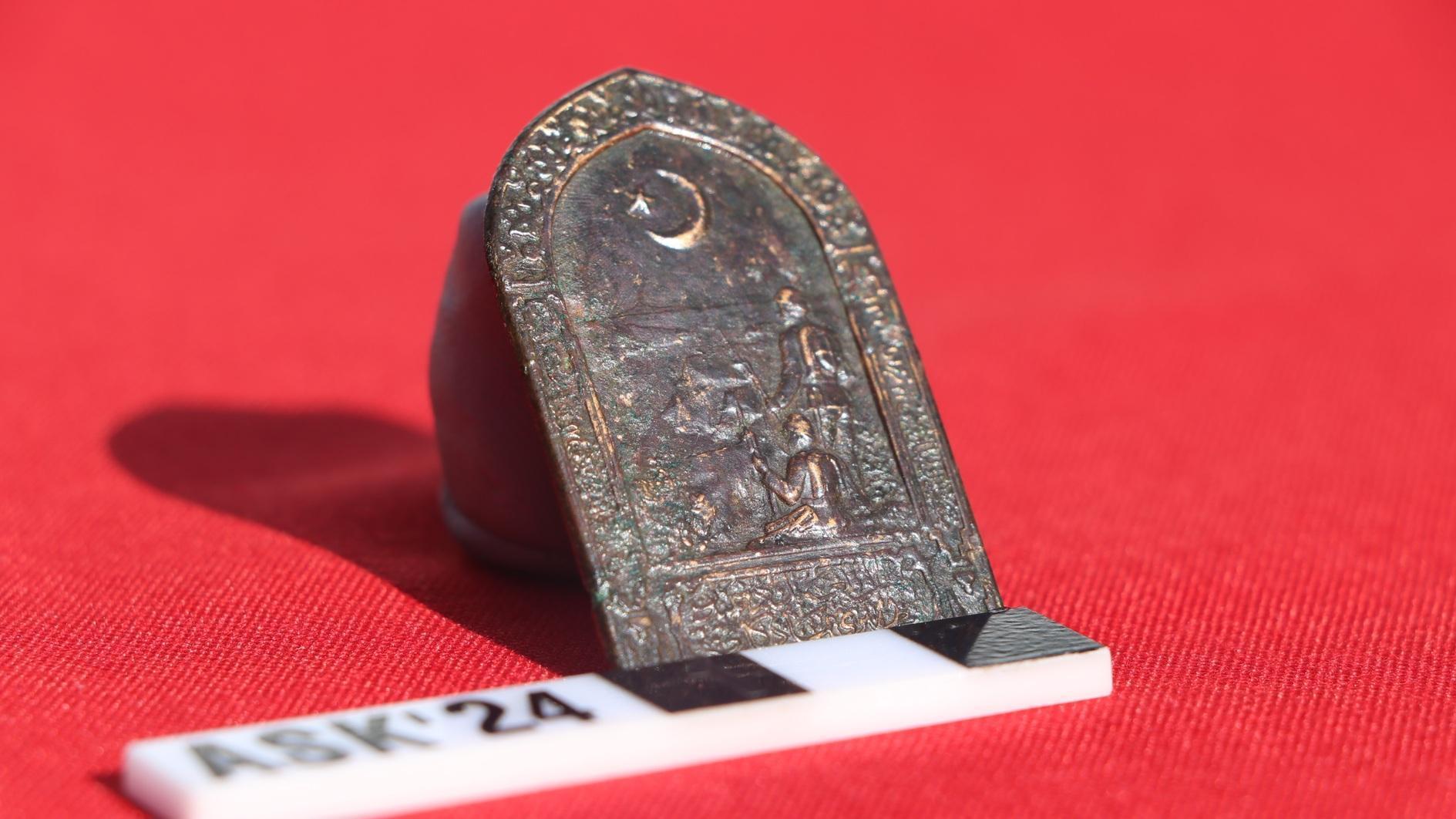Crying over Mongolian spilt milk
Aylin Öney TAN - aylin.tan@hdn.com.tr

Spilling or sprinkling milk droplets onto things, people or animals, or tossing a spoonful up in the air is a daily ritual in Mongolian life. REUTERS photo
Stuck in mud! It’s raining heavily. Early August in Mongolia feels like early autumn already. We, as the last few ones remaining in the bus, figure out that little hope is left of reaching a warm bed in the ger camp waiting for us. I think “No crying over milk spilt! There is nothing to do... We’re here for the night…”Strangely that fits to my state of mind. From the very beginning of our journey I cannot get rid of the thoughts that have been captivating me. Caught in this strange voyage, I also feel so badly entangled in my own life. May this is the first moment I begin to enjoy our Trans-Siberian-Mongolian track, finally taking an adventurous course. As we’re prepared to spend the night in the bus, a last rescue team arrives to fetch us to our camp. After a strenuous struggle through the muddy terrain, we reach our destination almost past midnight. To my surprise there is a hot meal waiting for us. A bowl of meaty noodle soup is heartwarming. I thoroughly savor my cabbage salad with a few shots of crystal pure Mongolian vodka. I cannot be happier to crawl into the bed to spend my first night in a Mongolian ger. The following days of our trip, there will be more and more ger nights, more vodka and lots more spilt milk!
Spilling or sprinkling milk droplets onto things, people or animals, or tossing a spoonful up in the air is a daily ritual in Mongolian life. Milk is sacred and holds a special place in the pastoral belief system. The livelihood of a nomad herder family practically depends on it. Milk must be the sole iconic food item in Mongolia. Along with meat, it is the source of sustenance in Mongolian existence. However, it also holds a particular significance as Tsagaan Idee, simply translated as “White Food”. Whiteness stands for purity, innocence, honesty, as well as representing a high social status, nobility and respect. White is associated with women and light, and considered as the mother of all colors. Milk is life, and offering milk back to nature will bring prosperity and abundance.
Milk in Mongolia comes from all five important animals usually essential for a complete herd: Horse, camel, sheep, goat, yak and/or cow. All milk types are used in cookery, and in making various preserved dairy products like aaruul/dried curd, eezgii/dried milk chunks and byaslag/cheese. Interestingly milk is seldom consumed raw, but often fermented to tarag/yogurt, or airag, famous fermented milk drink similar to kummis. Later, I’ll be astonished to read in a medical report that a great percentage of Mongolians can be lactose intolerant; according to a survey among 198 Mongols from Inner Mongolia, there were 174 lactose malabsorbers (87.9%). However, all Mongolians love to have a sip of their milk, and one popular way to enjoy it is in Mongolian tea. The Mongolian term for milk tea, süütei tsai sounds almost same in Turkish, sütlü çay. Through my first cup of süütei tsai, I’m astonished to find süü and süt are two words related in Mongolian and Turkish languages. The strong green tea with salty warm milk can taste strange to many, but it pleasantly embraces my palate.
When you enter a ger there is often milk simmering on the central stove, and immediately on the left-hand side of the entrance there is mare’s milk fermenting in a barrel, eventually turning into the ubiquitous airag. It is customary for anybody entering the ger, to give a good beating to the barrel. The games played in long nights often contains a punishment of thousands of beatings toiled over the airag barrel. High in protein, mare’s milk is also high in milk sugar lactose, so for many it is strongly laxative, and can only be consumed if fermented. Fermentation turns milk sugars into alcohol, thus airag is slightly fizzy in the mouth, reminiscent of sourish ayran, the savory yogurt drink in Turkish cuisine. It is an acquired to taste for most travelers, but not to this group of Turks who were brought up with ayran made with soured yogurt in their childhood.
The more I learn about milk in Mongolia, the more I keep remembering about the wonderful presentation of food and travel writer/researcher Sharon Hudgins on Tsatsal, ceremonial wooden milk spoons. Her talk at Oxford Symposium on Food & Cookery earlier this year was impeccable, giving a great insight on Mongolian rural life. Sharon has a small collection of those milk spoons, and she has generously shared all her knowledge with me before starting my trip. The spoons are long spatula like utensils, used solely for rituals, never for stirring or cooking milk. They’re often engraved with symbolic figures and the flat spatula-like spoon-part always bears three-by-three nine indentations, representing 9, the sacred and auspicious number to Mongolians. I desperately look for a nice Tsatsal for Sharon in the little shops and souvenir stalls we visit. Finally, a shy modest one smiles at me in a museum shop, one with a sun-rise pattern. That must be the one for her!
I feel happy imbibing on airag on my last night in a ger, with the help of fermented milk intoxication, I dream of clouds in my sleep. In my idyllic dream, I walk three times around an Ovoo, the Shaman shrine, and throw an unlocked chain onto the sky-high pile of sacrificial objects. I finally toss a spoonful of milk high up towards the clouds, and a drop each on my back and to both my sides.
I make three wishes, one for my daughter, one for our future life together, and one for myself, and repeat to myself:
No more crying over spilt milk!
It will bring luck...
Recipe of the Week: Boortsog is a fried dough often eaten as a sweet snack dipped in tea. Dissolve 75 g sugar and a good pinch of salt in 200 ml of boiled water, and mix with 75 g butter. Work all into a smooth dough with 500 g flour. Let the dough rest for an hour. Knead again and divide into fist sized pieces, roll out to 1 cm thickness. Cut into finger sized strips, rounds or lozenges. Deep fry in hot oil.
Bite of the week
Fork of the week: There is no Mongolian fare offered in turkey to my knowledge. However, just for the namesake one can try Mongolean Barbecue at Go Mongo: http://gomongo.com.tr/. Just keep in mind that Mongolian Barbecue is a totally newly invented dish, inspired by a food-cooking technique from Taiwan.
Cork of the week: Drink of the week should be airag, alas impossible to ferment mare’s milk at home. Instead make yourself a sütlü çay/süütei tsai before going to bed, or rather don’t, but just remember to make this on a cold autumn day: Brew a strongish green tea. Mix it half/half with warm milk. Add a generous pinch of salt and stir to dissolve. Enjoy!












